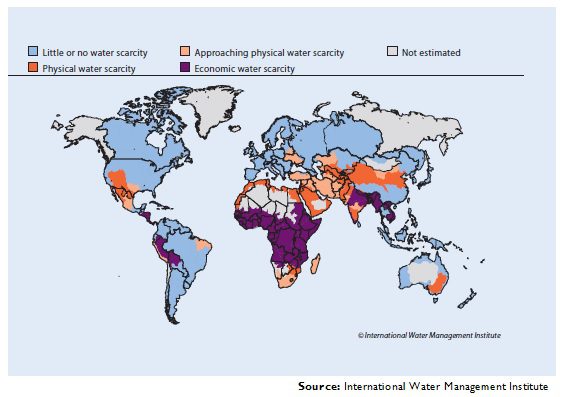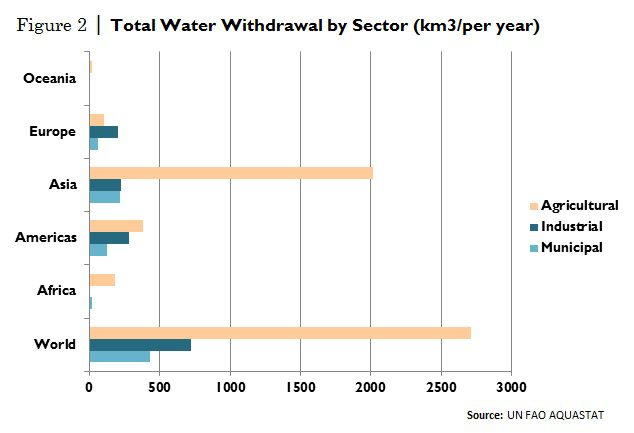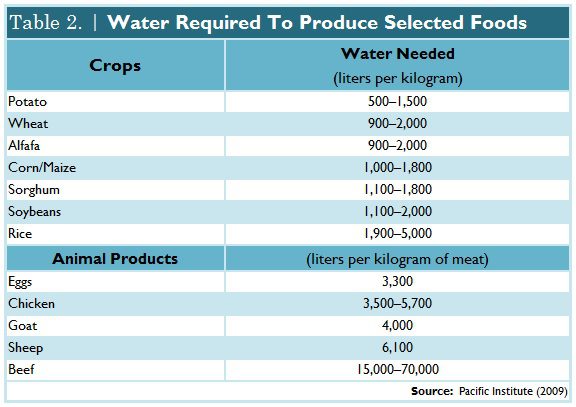Water resources face many pressures, including: population growth, increased urbanization and overconsumption, lack of proper management, and the looming threat of climate change. [This article looks at each area of water stress and offers suggestions on how they can be alleviated to a certain degree.] Words: 917; Charts: 4
So writes Supriya Kumar (http://vitalsigns.worldwatch.org) in edited excerpts from his original article* entitled The Looming Threat of Water Scarcity.
This post is presented compliments of Lorimer Wilson, editor of munKNEE.com (Your Key to Making Money!) and may have been edited ([ ]), abridged (…) and/or reformatted (some sub-titles and bold/italics emphases) for the sake of clarity and brevity to ensure a fast and easy read. Please note that this paragraph must be included in any article re-posting to avoid copyright infringement.
Kumar goes on to say in further edited excerpts:
Some 1.2 billion people—almost one fifth of the world—live in areas of physical water scarcity, while another 1.6 billion face what can be called economic water shortage. The situation is only expected to worsen as population growth, climate change, investment and management shortfalls, and inefficient use of existing resources restrict the amount of water available to people. It is estimated that by 2025 fully 1.8 billion people will live in countries or regions with absolute water scarcity, with almost half of the world living in conditions of water stress.
Water Scarcity Defined
Water scarcity has several definitions.
- Physical scarcity occurs when there is not enough water to meet demand; its symptoms include severe environmental degradation, declining groundwater, and unequal water distribution.
- Economic water scarcity occurs when there is a lack of investment and proper management to meet the demand of people who do not have the financial means to use existing water sources; the symptoms in this case normally include poor infrastructure.
Water Disparity by Area
To measure water scarcity, hydrologists compare the size of a population with the amount of available water. According to the United Nations, an area is said to be experiencing:
- water stress when annual water supplies fall below 1,700 cubic meters per person,
- water scarcity when supplies fall below 1,000 cubic meters per person, and
- absolute water scarcity is when supplies drop below 500 cubic meters a year.
Average Water Resources per Person (see Table 1):
- World: 6,236
- Canada: 85,310
- USA: 9,888
- Latin America: 7,200
- Europe: 4,741
- Caribbean: 2,466
- Asia-Pacific: 2,970
- sub-Saharan Africa: <1,000
- Arab countries: <500
Water Resource Pressures
Water resources face many pressures, including:
- population growth,
- increased urbanization and overconsumption,
- lack of proper management, and
- the looming threat of climate change.
According to the U.N. Food and Agriculture Organization (FAO) and UN Water, global water use has been growing at more than twice the rate of population increase in the last century [and with] world population predicted to grow from 7 billion to 9.1 billion by 2050, the strain on water resources to meet increased food, energy, and industrial demands [will be excreme].
Water Uses
At the global level:
- 70% of water withdrawals are for the agricultural sector,
- 11% are to meet municipal demands, and
- 19% are for industrial needs.
The above numbers, however, are distorted by the few countries that have very high water withdrawals, such as China, India, and the United States. A breakdown of water withdrawal by sector and region is shown in Figure 2.
Article Suggestions Wanted!
Read any interesting articles elsewhere that deserve wider readership?
Send the article URLs to editor{at}munKNEE{dot}com
Receive a Hat Tip should any get posted
Your own articles are welcome too
Agriculture is one the most water-intensive sectors, currently accounting for more than 90% of consumptive use….
- 44% among members of the Organisation for Economic Co-operation and Development (OECD),
- 60% within the eight OECD countries that rely heavily on irrigated agriculture and
- 74% in the transitional economies of Brazil, Russia, India, and China ranging from 20% in Russia to 87% in India.
Inefficient Farming Practises
Water use in agriculture is often inefficient, which has led to the overexploitation of groundwater resources as well as the depletion of the natural flow of major rivers, such as the Ganges in India and the Yellow River in China.
Of the total area available for irrigation:
- 54% is irrigated with surface water,
- 5% with groundwater, and
- 41% with a combination of both sources.
- When both sources are used together, less than 15% of it is surface water, which has led to a doubling of the global depletion of groundwater resources in the last 50 years.
The Ganges, Indus, and Yellow River basins in Asia have already reached high levels of water crowding and suffer from severe water shortage due to overuse….
Diet Changes
While the growing world population is increasing the pressure on land and water resources, economic growth and individual wealth are shifting people from predominantly starch-based diets to meat and dairy, which require more water. Producing:
- 1 kilogram of rice requires about 3,500 liters of water,
- 1 kilogram of beef needs some 15,000 liters. (See Table 2.)
This dietary shift has had the greatest impact on water consumption over the past 30 years and is likely to continue well into the middle of this century, according to FAO.
Growing Energy Needs
…All forms of energy require water at some stage of their life cycle, which includes production, conversion, distribution, and use. Energy and electricity consumption are likely to increase over the next 25 years in all regions, with the majority of this increase occurring in non-OECD countries. This will have direct implications for the water resources needed to supply this energy. It is anticipated that water requirements for energy production will increase by 11.2% by 2050 if the current mix of energy sources is maintained. Under a scenario that assumes increasing energy efficiency of consumption modes, the World Energy Council estimates that water requirements for energy production could decrease by 2.9% by 2050.
Climate Change
Climate change will also affect global water resources at varying levels.
- The semi-arid areas of the Americas, Australia, and southern Africa…will see reductions in river runoff and aquifier recharge in regions that are already water-stressed.
- In Asia—in particular, in countries such as Pakistan—the large areas of irrigated land that rely on snowmelt and high mountain glaciers for water will be affected by changes in runoff patterns.
- Highly populated deltas are at risk from a combination of reduced inflows, increased salinity, and rising sea levels.
- Rising temperatures will translate into increased crop water demand everywhere.
To combat the effects of climate change, efforts must be made to follow an integrated water resource management approach on a global scale. This involves water management that:
- recognizes the holistic nature of the water cycle and the importance of managing trade-offs within it,
- emphasizes the importance of effective institutions, and
- is inherently adaptive.
Editor’s Note: The author’s views and conclusions in the above article are unaltered and no personal comments have been included to maintain the integrity of the original post. Furthermore, the views, conclusions and any recommendations offered in this article are not to be construed as an endorsement of such by the editor.
*http://vitalsigns.worldwatch.org/vs-trend/looming-threat-water-scarcity (© 2010 | Worldwatch Institute)
Stop Surfing the Net!
Enjoy this site? Like to have every article sent to you?
Go HERE and sign up to receive your Intelligence Report
It’s FREE but limited to only 1000 active subscribers
Spread the Word!
Tell others about one of the highest quality (content and presentation) financial sites on the internet
Unique visits/pageviews are doubling yearly & time-on-site continues to reach new highs
munKNEE should be in everybody’s inbox and MONEY in everybody’s wallet!
Related Article:
1. munKNEE.com: “Internet’s most unique site for financial articles” – Here’s Why
There is need to spend time searching the internet looking for articles worth reading. We do it for you and bring them to you each day on this the “internet’s most unique site for financial articles” and in our newsletter, the “Intelligence Report”
 munKNEE.com Your Key to Making Money
munKNEE.com Your Key to Making Money




